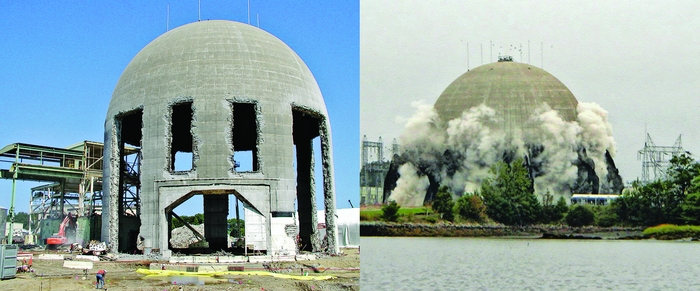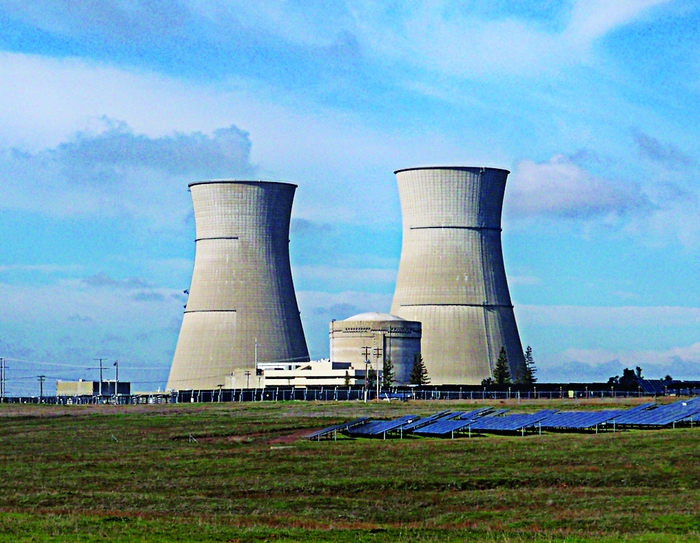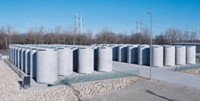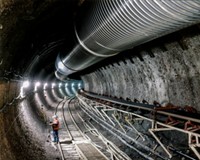Advertisement
Grab your lab coat. Let's get started
Welcome!
Welcome!
Create an account below to get 6 C&EN articles per month, receive newsletters and more - all free.
It seems this is your first time logging in online. Please enter the following information to continue.
As an ACS member you automatically get access to this site. All we need is few more details to create your reading experience.
Not you? Sign in with a different account.
Not you? Sign in with a different account.
ERROR 1
ERROR 1
ERROR 2
ERROR 2
ERROR 2
ERROR 2
ERROR 2
Password and Confirm password must match.
If you have an ACS member number, please enter it here so we can link this account to your membership. (optional)
ERROR 2
ACS values your privacy. By submitting your information, you are gaining access to C&EN and subscribing to our weekly newsletter. We use the information you provide to make your reading experience better, and we will never sell your data to third party members.
Nuclear Power
Nuclear Retirement Anxiety
As nuclear power plants age, concerns grow over financing, complexity, and safety of decommissioning
by Jeff Johnson
April 1, 2013
| A version of this story appeared in
Volume 91, Issue 13

Over the past few months, nuclear power plants have hit a rough spot.
The owners of the Kewaunee Power Station in Wisconsin and Florida’s Crystal River 3 Nuclear Plant announced they were prematurely shutting the plants down, pointing to economic problems driven by growing maintenance costs and competition with cheap natural-gas-fueled power plants. The announcement marked the first nuclear plant shutdowns in 15 years, according to the Nuclear Regulatory Commission (NRC).
More retirements are likely. Kewaunee is 39 years old; Crystal River is 36. The designed age for nuclear reactors in the U.S. is 40 years. The average age of the 104 working plants is 32 years, according to the Energy Information Administration (EIA), a part of the Department of Energy. With age is sure to come more maintenance, more outages, and greater safety concerns for communities living near the plants. Other operators are likely to take the path chosen by Kewaunee and Crystal River and begin the lengthy, complex, and expensive process of shutting down, cleaning up, and decommissioning.
Those that keep going will struggle with the difficulty of keeping an aging facility operating. For example, in California, two huge reactor units at the San Onofre Nuclear Generating Station have been idled since January 2012 because of premature wear and leakage of steam generator tubes that had just been replaced at a cost of $670 million. The units supply 2,200 MW or around 20% of the power for the surrounding Southern California area. According to recent NRC statements, it is unclear when the commission will allow the two to start up again. These two reactors join a third out-of-use California reactor at San Onofre. This one was shuttered in 1992 and is being decommissioned.
And in Nebraska, the Fort Calhoun reactor has been off-line for two years, first because of flooding from the Missouri River, which led to repairs and a lengthy NRC reexamination. The inspections turned up other problems that continue to block the facility from operating.
These closings coupled with shutdowns for planned and unplanned maintenance have resulted in the highest number of nuclear power plant outages in the past five years, says a recent EIA report.
Yet to be seen will be the impact on aging power plants of new safety and maintenance requirements springing from NRC’s analysis of the Fukushima Daiichi nuclear power plant accident in Japan. That tragedy happened two years ago this spring. Under a phased schedule, NRC is requiring new safety additions for 31 U.S. reactors that are similar in design to the three Japanese reactors that suffered a meltdown and released radioactive materials following an earthquake and tsunami.
The new requirements include emergency backup power and instrumentation to ensure spent-fuel pools operate adequately. All these reactors must also now have hardened vents for reactor containment structures to relieve pressure and discharge built-up hydrogen during a reactor vessel accident. NRC is also contemplating requiring filters to capture vented radioactive material.
It isn’t all bad news for the nuclear power industry, which supplies nearly 20% of U.S. electricity. Industry analysts note that several new reactors are in planning and a couple are beginning construction.
But these new starts aside, greater focus is being placed on how to decommission sites as more are retired.
Kewaunee and Crystal River will join 29 U.S. commercial and research reactors going through decommissioning. Eight smaller reactors have had their spent fuel and other highly radioactive components moved off-site to DOE nuclear facilities. Another seven commercial nuclear power plants are now greenfield sites with low-level radioactive debris and hazardous waste moved to off-site disposal locations. However, spent fuel and highly radioactive internal components remain on-site, stored in concrete and steel casks resting on concrete pads. These casks wait for the conclusion of a national debate to locate and build a permanent nuclear waste repository or an interim storage facility.
The remaining 14 reactors are in various stages of decommissioning; some have been there for a long time. The Humboldt Bay Power Plant near Eureka, Calif., for instance, was shut down in 1976 and has not been completely cleaned up, according to NRC figures.
Decommissioning is a big-ticket item. Taking down a power plant calls for special technologies and experience as well as a lot of money. At the cheap end, it can cost about $400 million to clean up a single commercial nuclear power plant reactor, says NRC. Doing the math, the price tag to decommission the fleet of 104 reactors will exceed $40 billion—by how much will depend on whether the nuclear industry continues its history of cost overruns.
To cover decommissioning costs, NRC requires power plant owners to set aside cleanup funds. Every two years companies must submit reports to NRC, which the commission checks to ensure the funds are safe and adequate. Money is raised through a fee on electricity ratepayers, and funds are invested, like a person’s retirement fund. And like retirement funds, when the stock market tanks so do the nuclear trust funds.
As retirements near, NRC’s oversight of the trust funds becomes paramount. Last year, a review by the Government Accountability Office, the investigative arm of Congress, challenged NRC’s formula for determining the size of funds. The GAO report charges that the formula lacks detail and transparency, and in a sample of power plant savings programs, the report found NRC’s formula may underestimate cleanup costs.
GAO investigated 12 reactors’ trust funds, comparing company-prepared site-specific decommissioning cost estimates to NRC’s formula. For nine reactors, NRC’s formula resulted in funds below the companies’ estimates. In one case, a company believed it needed $836 million, which was $362 million more than NRC’s formula figure. GAO also noted NRC’s funding formula was more than 30 years old.
The Anatomy Of Decommissioning
Cleaning up a retired nuclear reactor is a long, costly, and complex process.
1. Owner shuts down plant and notifies Nuclear Regulatory Commission, starting the 60-year decommissioning time clock. Within two years, the plant owner issues a plan that includes goals, a timeline, and a cost estimate.

\
2. Reactor fuel is removed from core and spent fuel is removed from on-site storage pool. Both are placed in concrete and steel canisters that are constructed on-site. Highly radioactive material is removed from the reactor pressure vessel and is also stored on-site in canisters. The pressure vessel itself is kept intact to be shipped to a low-level waste disposal facility.

\
3. Millions of pounds of concrete and other debris are broken down and shipped to a low-level waste and hazardous waste disposal site.
4. Spent fuel and other more radioactive wastes remain on-site in casks resting on a cement slab, waiting to be moved after selection and construction of a national high-level radioactive waste facility.
5. When completed, site must be decontaminated and available for general use with radiation below a standard of less than 25-millirem annual exposure.
Sample Figures
◾ Rancho Seco (top) was a 900-MW reactor in Sacramento that ran from 1975 to 1989; its shutdown cost more than $500 million and took nearly 20 years to decommission. It has some 22 casks stored on-site.

\
◾ Maine Yankee (below) was a 900-MW plant that cost $568 million to clean up; the site has 60 dry cask storage containers. It took eight years to decommission.

\
NRC agrees with some of the report’s recommendations but notes that the decommissioning formula is just one of many inputs into NRC’s regulatory system to oversee the trust funds. NRC stresses that it assumes the trusts will grow over time and that market fluctuations will even out over the lifetime of a nuclear power plant.
An internal NRC study in 2009 also found problems with the trust funds. The study found 27 reactors had insufficient funds and in the aggregate would result in a shortfall of $2.4 billion in cleanup money.
About half of the trust funds’ shortfall was due to eight plants owned by Exelon Corp., which operates the largest subset of the nation’s nuclear fleet. A follow-up report, released two years later, found the trusts’ shortfall was mostly resolved by a rising stock market. However, according to a Jan. 31 letter from NRC to Exelon, NRC is still investigating Exelon over allegations that in the past it deliberately inflated funding set aside in its decommission trust for some 17 reactors it operates.
NRC regulations allow a combination of three decommissioning options: immediate dismantlement, a delay of up to 60 years before beginning dismantling, or permanent reactor entombment in which radioactive contaminants are permanently encased on-site. To date, none of the 29 reactors being decommissioned is being entombed, NRC notes.
For a couple of reasons, the 60-year option was thought to be the decommissioning path of choice, says Ralph Andersen, a physicist and senior director of radiation safety and environmental protection for the Nuclear Energy Institute, a trade association. The long delay will let radionuclides in spent fuel decline in radiation and heat, making the waste easier and cheaper to handle during decommissioning, Andersen notes. Also, the time gives companies a chance to build up equity in their stock holding should the market crash around the event of a plant retirement. However, only eight reactors have selected that wait-and-watch path, according to NRC.
Operators of the remaining reactors being decommissioned are opting to begin immediate dismantling. Immediate in nuclear terms, however, is measured is decades.
Shutdown decisions, historically, have been driven by costs, such as expensive repairs or maintenance, particularly when they affect a single isolated plant, Andersen says. And for an economically stretched company, a relatively quick dismantlement may avoid continued costs for upkeep and security. Toss in local nuclear opposition, and plant owners really want out.
For instance, Maine Yankee, a 900-MW power plant in Wiscasset, Maine, was dogged for years by community allegations of safety problems and three unsuccessful referendums to shut it down. In 1997, rather than comply with NRC-identified repairs, the plant just closed. After running for 24 years, the plant began immediate decommissioning, which was complete in 2005 at a cost of $568 million.
About the same size is Sacramento’s Rancho Seco Nuclear Generating Station that ran from 1975 to 1989. It was shut down the day after a referendum ordering the plant to close was passed. The demolition dragged on for nearly 20 years and cost more than $500 million.
Andersen, however, believes stories like these will not be repeated. Plants will continue operating, and decommissioning will take a new model, he says.
“There undoubtedly will be the creation of a huge decommissioning industry,” Andersen says. “The money on the table is so great it will invite a level of decommissioning entrepreneurship that is hard for me to imagine.”
He predicts decommissioning will be done by specialized companies focusing on several shuttered power plants at once and using new technologies and economies of scale.
The future, Andersen says, can be seen near Chicago at a decommission project just getting under way at Exelon’s Zion 1 and 2 reactors. Taken together, the reactors are the largest ever to be decommissioned.
The two plants ended operations in 1996, notes Craig Nesbit, an Exelon spokesman. Since then, the plants have simply sat idle. He explains that Exelon didn’t have enough money in its trust fund to cover the cleanup and was waiting for the fund’s investment to grow. The company estimated it would need until the late 2020s to begin.
But several years ago, Exelon was approached by EnergySolutions, a nuclear waste company founded in 2007 and made through a merger of four waste disposal companies—Envirocare of Utah, Scientech D&D, Duratek, and BNG America, the U.S. subsidiary of British Nuclear Fuels. EnergySolutions owns a low-level nuclear waste disposal site in Clive, Utah, and operates a similar site in South Carolina. It is also part of team of contractors working to remediate tank wastes at DOE’s Hanford nuclear cleanup site and has global radioactive cleanup operations.
Mark Walker, EnergySolutions vice president for marketing, says that while talks with Exelon were moving ahead, EnergySolutions began to have second thoughts. The stock market crashed and the decommissioning fund lost 20% of its value, dropping to near $700 million. “We couldn’t do it at that level. But with the economic recovery, the fund returned to $800 million to $900 million, and we went ahead.”
Exelon transferred its NRC license to EnergySolutions two years ago, and the cleanup is getting under way, Walker explains. EnergySolutions has committed to dismantling the facilities by 2020 and will lower costs by sending waste to its own site in Utah.
Retirement
Shuttered nuclear reactors are scattered across the U.S.
View Retirement in a larger map
Source: Nuclear Regulatory Commission
But David A. Kraft has doubts. Kraft is the director of the Nuclear Energy Information Service, a Chicago-based nuclear watchdog group. He is concerned about the overall arrangement, particularly financing, market fluctuations, and NRC’s oversight of the cleanup.
“The trust fund is ratepayer money,” he says, noting that under Illinois law whatever is left after decommissioning must be returned to the ratepayers. So far, he says, auditing has been inadequate, making it unclear where the funds are being spent. In late February, the first auditing report was made public, he says. “It was only two pages—for an $860 million job.”
In addition, Kraft notes EnergySolutions is currently being purchased by Energy Capital Partners, a private equity firm. This acquisition follows volatility of EnergySolutions’ stock price. Last June, EnergySolutions lost half its value in a single day when it cut its profit outlook for the year and replaced its chief executive officer and chief financial officer. The firm has had two CEOs and several CFOs in the past three years.
Advertisement
Kraft worries about liability and what might happen if the decommissioning fails while exhausting the trust fund. He says he raised these issues with NRC Chairman Allison M. Macfarlane earlier this year.
And while Kraft was pleased to have the ear of the NRC chief, he says he felt the commission does not recognize the importance and difficulty securing and maintaining decommission financing that will ensure a safe and timely cleanup.
However, Macfarlane says, NRC intends to focus more attention on decommissioning in light of the Wisconsin and Florida closings. Speaking at a regulatory conference on March 12, she said the commission will examine its decommissioning regulations to ensure they are current and appropriate in preparation for more possible shutdowns.
“The decommissioning reexamination is essential,” she added. “We must ensure that our regulations are sufficiently comprehensive and robust to address issues that will arise long after most of us are retired.”
Her comments recognized a singular fact that only applies to nuclear power: its lengthy timescale. Consider that NRC regulations allow owners to put off decommissioning for 60 years after a plant ceases operation, and add those years to a reactor’s normal 40-year operating license plus a 20-year extension that has been granted to 73 reactors. That timescale—from construction to decommissioning completion—will easily exceed a human lifetime, let alone a regulator’s professional career.




Join the conversation
Contact the reporter
Submit a Letter to the Editor for publication
Engage with us on Twitter